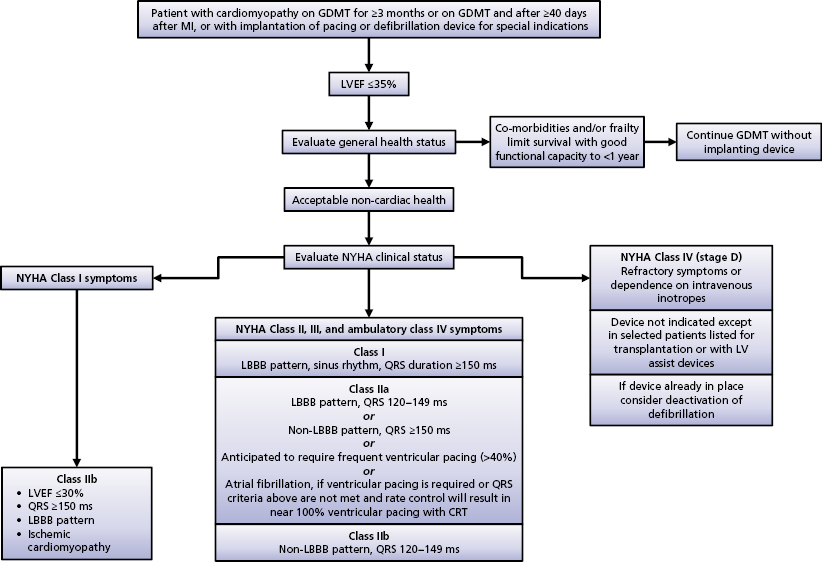Some patients with. Since its initial approval in 2001 the indications for cardiac resynchronization therapy have evolved and become more inclusive.
 9 Cardiac Resynchronization Therapy Thoracic Key
9 Cardiac Resynchronization Therapy Thoracic Key
New indications were then established for atrial fibrillation pacemaker-dependent and mildly symptomatic.

Cardiac resynchronization therapy indications. Epidemiology prognosis. This has implications for the optimal programming of ICDs. The indication for cardiac resynchronization therapy CRT using biventricular pacing or ICD systems has to be highly differentiated to optimize the proportion of patients who derive significant symptomatic benefit from this therapy on the one hand and to avoid this invasive treatment in patients with a low probability of clinical success of CRT on the other hand.
Indications for cardiac resynchronization therapy. Introduction to indexes for cardiac resynchronization therapy CRT indication. Citation counts are provided from Web of Science and CrossRef.
The counts may vary by service and are reliant on the availability of their data. Specifically COMPANION and CARE-HF trials involved a turning point for cardiac resynchronization therapy which became well recognized for the treatment of heart failure patients with QRS120 ms ejection fraction35 and sinus rhythm to reduce hospitalizations and all-cause mortality. New indications were then established for atrial fibrillation pacemaker-dependent and mildly.
Cardiac resynchronization therapy CRT is a modality of cardiac pacing used in patients with left ventricular LV systolic dysfunction and dyssynchronous ventricular activation that provides simultaneous or nearly simultaneous electrical activation of the LV and right ventricle RV via stimulation of the LV and RV biventricular pacing or LV alone. Over 10 million scientific documents at your fingertips. Based on newer data post hoc analyses and meta-analyses.
Indications for cardiac resynchronization. We used five databases NHS Economic Evaluation Database Cochrane Library. 1 Web of Science.
This study planned to systematically review cost-effectiveness of CRT combined with an implantable cardioverter-defibrillator ICD versus ICD in patients with HF. Cardiac Resynchronization Therapy CRT Its History Indication Usefulness and Problems. Initial studies established patient selection criteria for cardiac resynchronization therapy CRT as left ventricular ejection fraction less than or equal to 35 QRS greater than or equal to 120 ms and New York Heart Association 3-4.
Cardiac Resynchronization therapy has become an important management tool in adults with heart failure and dilated cardiomyopathy. Indications for cardiac-resynchronization therapy CRT in patients with heart failure include a prolonged QRS interval 120 msec in addition to other functional criteria. CRT has been shown to reduce morbidity and mortality in selected patients with systolic heart failure.
Patients in sinus rhythm. Kazuo Matsu moto MD. WHAT THE STUDY ADDS CRT device implantation has been established as a.
Longer-term prospective evaluation of these differences is warranted and should be investigated in the broader ICD patient population. Patients receiving an ICD for CRT therapy with primary prevention indications have a different clinical arrhythmia course than patients with a history of spontaneous VTVF. Cardiac resynchronization therapy CRT is a mechanical device that helps to recover ventricular dysfunction by pacing the ventricles.
Specifically COMPANION and CARE-HF trials involved a turning point for cardiac resynchronization therapy which became well recognized for the treatment of heart failure patients with QRS120ms ejection fraction35 and sinus rhythm to reduce hospitalizations and all-cause mortality. The role of CRT in children with CHF is still unclear. This study compares and contrasts the recommended indications for cardiac resynchronization therapy CRT according to the most recent guidelines from international cardiology societies.
Counts will update daily once available. Patients in atrial fibrillation. Patients with heart failure.
Cardiac resynchronization therapy CRT is an important and effective treatment option for patients with advanced heart failure.
